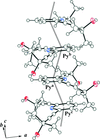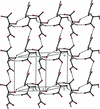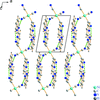issue contents
November 2020 issue

Cover illustration: In the search for new compounds with potential pharmaceutical applications, the new nitrobenzamide derivative N-{3-[(4-methoxyphenyl)carbamoyl]phenyl}-3-nitrobenzamide was synthesized and thoroughly characterized. The structure is held by a network of strong N-H O and C-H
O and C-H O hydrogen bonds. Hirshfeld surface analysis indicates these interactions, along with H
O hydrogen bonds. Hirshfeld surface analysis indicates these interactions, along with H H and H
H and H C/C
C/C H contacts, contribute close to 90% to the crystal packing. The coupling of the title compound and of the well-known anticoagulant Apixaban with the human coagulation factor hfXa as the receptor protein was evaluated through molecular docking studies, indicating the compound has inhibitory activity. See: Moreno-Fuquen, Hurtado-Angulo, Arango-Daraviña, Bain & Kennedy [Acta Cryst. (2020). E76, 1762-1767].
H contacts, contribute close to 90% to the crystal packing. The coupling of the title compound and of the well-known anticoagulant Apixaban with the human coagulation factor hfXa as the receptor protein was evaluated through molecular docking studies, indicating the compound has inhibitory activity. See: Moreno-Fuquen, Hurtado-Angulo, Arango-Daraviña, Bain & Kennedy [Acta Cryst. (2020). E76, 1762-1767].
research communications








































 journal menu
journal menu






































